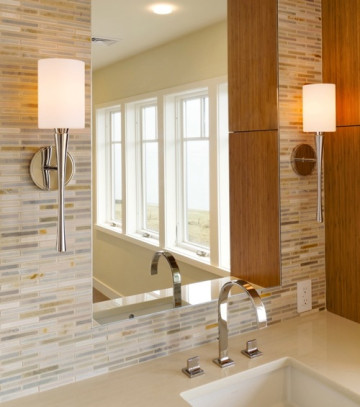DESIGN LINE: 10 Things You Need To Know About Lighting Your Home
Tuesday, May 28, 2013
Side-lighting a bathroom's mirror not only makes the room more interesting, but casts a more flattering light on your features. Design: KTID, Photo: Nat Rea.
Tip 1: Side-light a Mirror
How many times have you walked into a bathroom and there’s one overhead light and a light over the mirror? Do you like the bags under your eyes? I don’t. The best advice I can give you is to remember that overhead lighting creates shadows on your face, so that light over your mirror only amplifies those bags. Do whatever you can to get that light on the side.
Tip 2: Lighting a Counter
If you are trying to light a work surface (like a kitchen counter) from above, keep in mind that your body will be standing at the counter while you work. That means if the lighting is behind your body, you will shadow all that great light. I like to place recessed lighting right at the edge of the counter. This way, all the light will fall right where you need it to.
GET THE LATEST BREAKING NEWS HERE -- SIGN UP FOR GOLOCAL FREE DAILY EBLASTTip 3: Lighting Art
Lighting art is a tricky business, and there are a few ways to do it. My preference is a mixture of recessed directional or track lighting and good old fashioned picture lighting. If you have a large collection, track can be nice (one track head per piece of art). Use individual picture lights to highlight a special piece here or there. Just make sure the light is not too far away from the piece or too close and that the light you choose has enough spread to cover the whole picture.
Tip 4: Grazing a Wall
A textured wall deserves to be a showcase. Perhaps you have a stone fireplace or some exposed brick. Lighting on the ceiling very close to the wall will allow the light to gently graze the surface, highlighting that texture while creating dramatic light and dark shadows over the surface.
Tip 5: Recessed Lighting
Recessed lighting doesn’t have to be bad-looking, particularly with LED technology where it is now. LED recessed are the only recessed I specify these days, as the cost has come down, and the light quality is far
The combination of a well-placed chandelier and warming sconces offer rich lighting possibilities in this Barrington dining room. Design: KTID, Photo: Nat Rea.
Tip 6: Lighting a Dining Room/Kitchen Table
All too often, I see a chandelier hanging over a table that is either way too high or way too low. I have a general rule, which is just that--general. Most of the time, I want the bottom of the fixture to be between 30-36” over the top of the table. You want your diners to be able to see each other without too much glare. On the other hand, this is one place where the light fixture can be the focal point of the room, so too high a light won’t properly light your table or give your dining space any added drama.
Tip 7: Under-Cabinet Lighting
Please, whatever you do, do not buy those long, cheap, thick under cabinet light-boxes! Yuk. Under cabinet lighting is now available in the size of a 1/8” piece of tape, full of LEDs that light your surface brightly and cannot even be seen under the edge of a cabinet.
Tip 8: Mixing Fixtures
Drama is created by layers of light spilling into each other. Don’t forget that a nice mix of general, task and accent lighting will add a colossal amount of character to your space. Some lights are not about output, so think of them as art. Sconces may give very little purposeful lighting in a dining room, but act as an accent, adding a little bit of light and a lot of character.
Tip 9: Light Quality
Too many times I see spaces lit so evenly everywhere that I have no sense of the light quality at all. Every space doesn’t need to be extremely well-lit. Remember that passing through a bit of a darker space to enter a lighter one creates a journey through your space, romance and drama.
Tip 10: Dimming
Almost every light fixture in my home is on a dimmer, and when I design lighting, this is a must. In the bathroom, it’s not terribly necessary, but you may want to consider it for a powder room that may be home to many guests at a party. Having the ability to adjust light levels, especially with overhead lighting, can give you an enormous amount of control over the way your space feels.
Good luck, and KTID is always here if you need some guided professional help on your journey through the wide world of lighting.
Kelly Taylor has 15 plus years of experience in the field of interior design. She is the 2012 recipient of New England Home magazine’s “5 Under 40” award for excellence in design as well as Rhode Island Monthly magazine’s 2012 Gold Award for residential interior design. She practices residential and commercial interior design in Providence, Rhode Island. Please find her on twitter at @ktidnet, visit her website at www.ktid.net or check her out on Facebook at http://www.facebook.com/KellyTaylorInteriorDesign.
Related Articles
- DESIGN LINE: 10 Great Table Lamps
- DESIGN LINE: 10 Kitchen Upgrades On A Budget
- DESIGN LINE: 10 Ways To Freshen Up Your House On a Budget
- DESIGN LINE: 7 Steps To a Great Home Renovation
- DESIGN LINE: 7 Steps To a Renovated Basement
- DESIGN LINE: Best Paint Colors For Interiors
- DESIGN LINE: Selecting Stone Counters
- DESIGN LINE: Interior Design Q&A
- DESIGN LINE: How To Hire (and Work With) An Interior Designer





